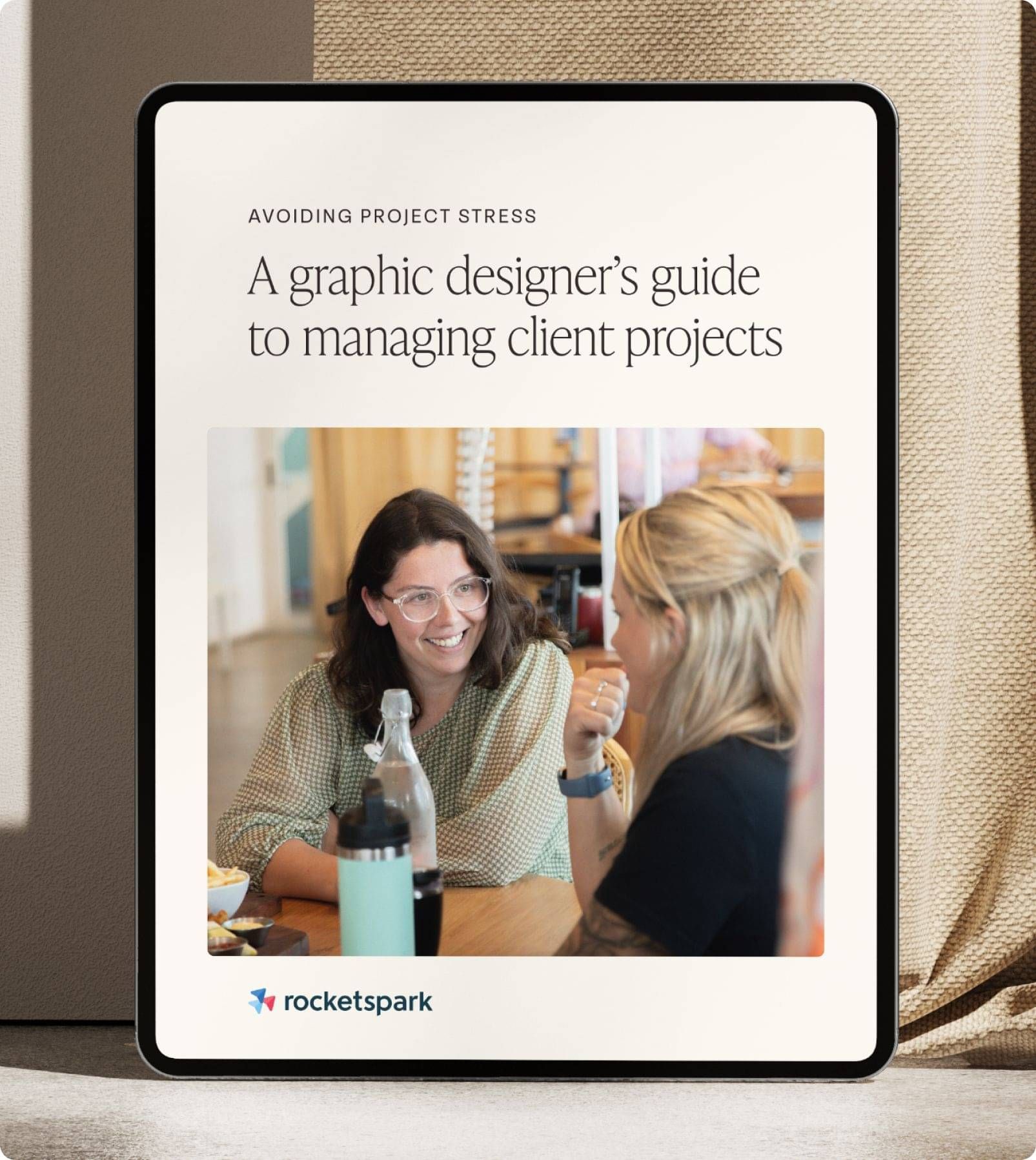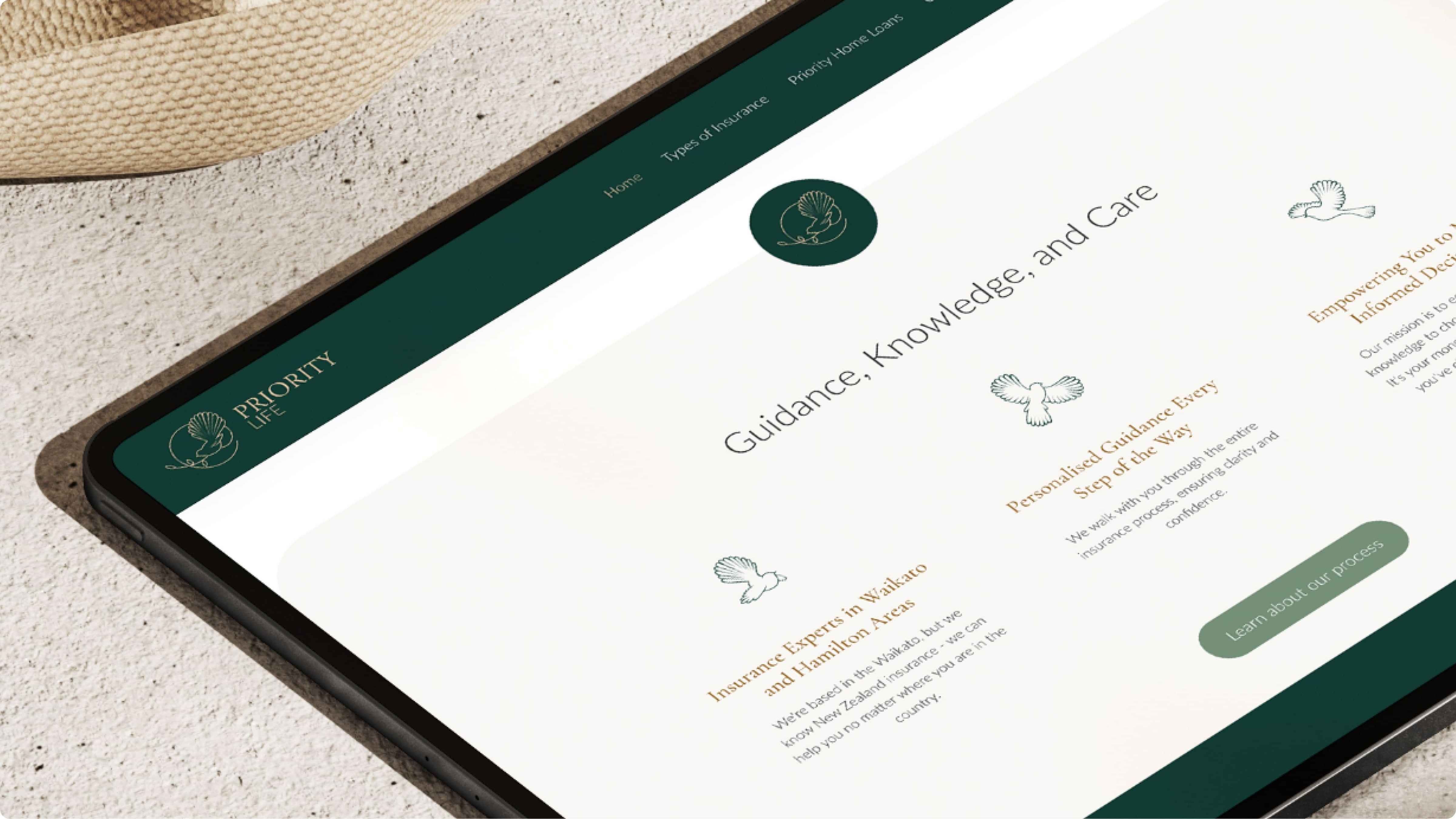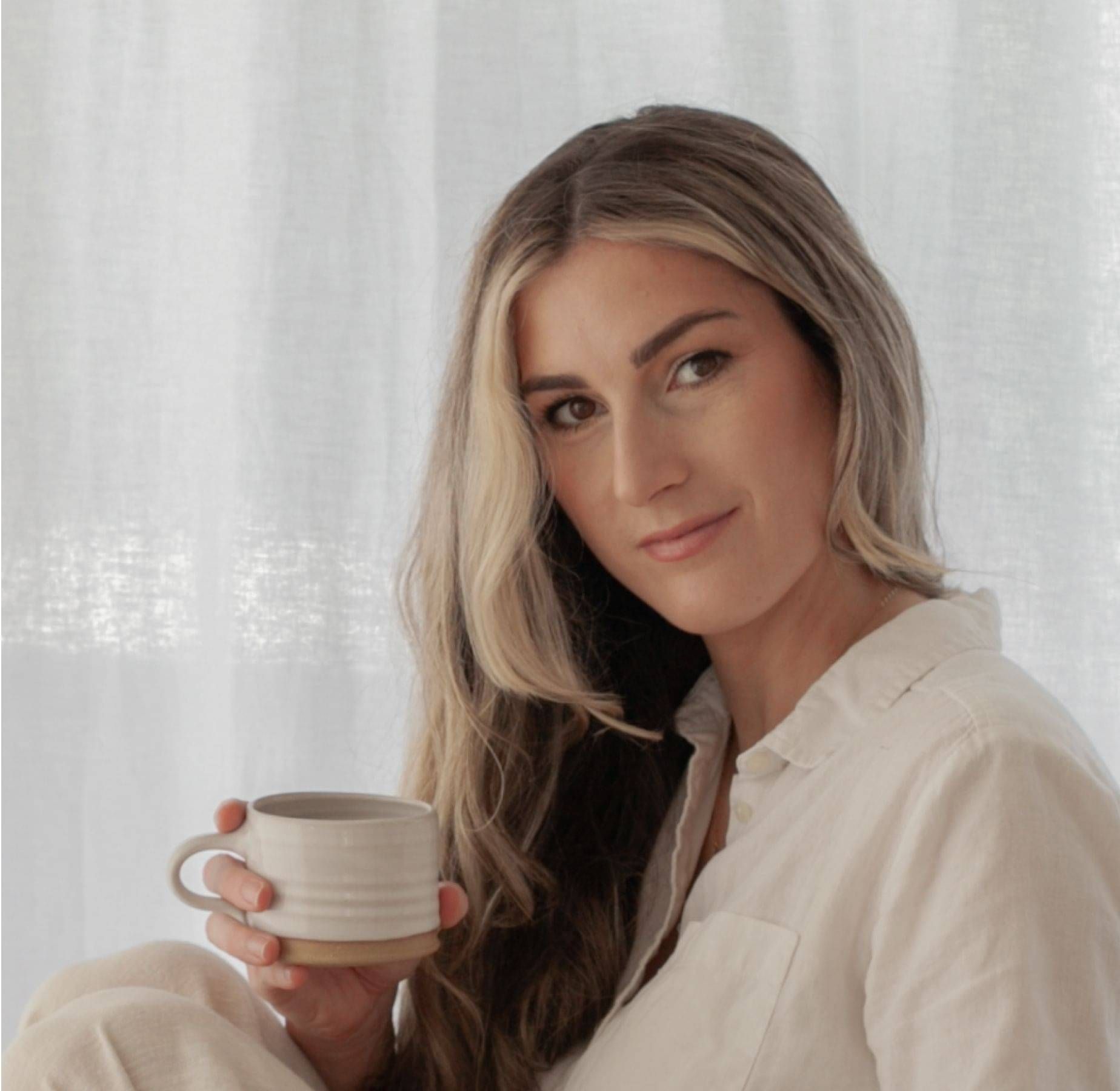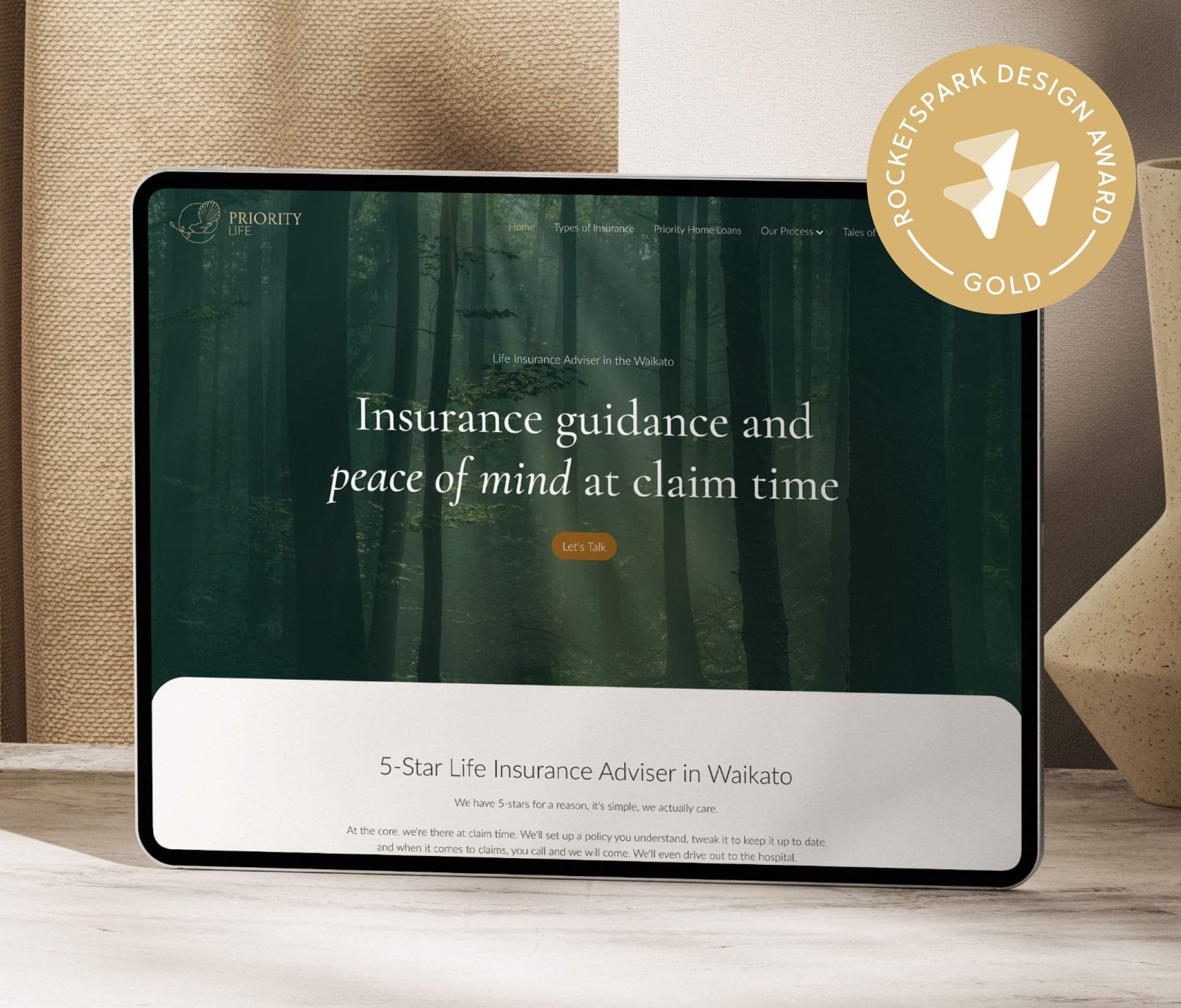INTERVIEW WITH LEAH FROM LADEDA
To have Rocketspark be a design cheerleader for me means so much!
Leah talks through her brand-first approach, how she gets the most out of client collaboration, and what it means to her to win a Gold Rocketspark Design Award.
After recently starting her own design studio, Ladeda, Leah had to back herself every step of the way. Winning a Gold Rocketspark Design Award for her client’s site, Priority Life, gave her added validation and confidence that she’s on the right track.
Leah recently launched her own studio and is going from strength to strength in both design and business.
Leah from Ladeda is a talented brand and web designer, and part of the Rocketspark Design Partner community. She recently won a Gold Rocketspark Design Award for her work on the Priority Life website—a project made even more unique by the fact that her client was also her brother.
In this candid interview, Leah shares the full story—from shaping the brand and building trust, to refining content and navigating collaboration. She also opens up about the realities of imposter syndrome, and what helps her feel more confident through the process.
🎁 Want support with your next client project? Download the free PDF guide packed with practical tips to help you deliver smoother, more successful work, just like Leah.
Rocketspark has got your back every step of the design journey
Running your own design studio takes courage, but you don’t have to do it the hard way. This free ebook gives you the tools to lead website projects with clarity and confidence.

INTERVIEW WITH LEAH FROM LADEDA
1. Tell us a bit about your business, Ladeda?
I started Ladeda a little over a year ago now. My focus is really around building Rocketspark websites. I love working solely with Rocketspark, so in terms of building websites, this is my platform of choice.
I like to, if possible, do the whole shebang: branding, all their marketing assets and visual identity pieces that go along with the business, and then the website too. If I can do everything in one project, it’s beautiful. I focus on branding, communication design, and websites, basically anything your business has as a visual touchpoint with your clients.
2. What sort of work do you enjoy the most?
My favourite is when I can be that one-stop shop for people. We can work on brand strategy, their business, mission, values, how they want to be perceived, and then translate that visually. The branding right through to the website and everything else I’m doing, it just feels really cohesive.
3. Can you tell us a bit about the Priority Life project? How did it come about?
Priority Life is actually run by my brother, Zak. I do want to say that he did pay me for this gig, we support each other in business. I use his insurance company for all my stuff, and he uses me for design.
It’s a cool kind of symbolic relationship we have. Priority Life is life insurance for anybody and everybody across New Zealand. It’s a sister company to Priority Home Loans. They have a great relationship where they feed clients to each other. Zak’s focus is just to make sure everyone has access to insurance, and he really cares, especially when it comes to claim time.
4. What was the starting point for the website? Was there anything already in place?
Zak had no online presence, except for a Google account, which was actually doing really well with reviews.
So for me, it was a clean slate. A blank canvas. We got to jump into brand strategy, unpack what’s important to him, and then translate that into the website. It was exciting, we were painting the full picture from scratch.

“My favourite is when I can be that one-stop shop for people. We can work on brand strategy, their business, mission, values, how they want to be perceived and then translate that visually.”
— Leah, on her favourite projects
5. Did you create the brand before you started designing the website?
Yes, 100%. We came in focusing on the brand first. Zak had a real connection to the Pīwakawaka, the fantail, which is the symbol in his logo.
For me, that made perfect sense. The fantail is symbolic of messages, often representing communication between life and death, which is a meaningful tie-in to life insurance. It led everything, branding, colours, tone.
Because the fantail lives in nature, the colour palette followed suit. We still wanted trust to come through, which green and natural colours often represent. From there, I had creative freedom. And because of who Zak is, he just trusted me. It was a really smooth branding process.
6. What was your creative vision, and did it evolve as you worked on the site?
The big goal was trust. He’s handling people’s lives, their futures, so it was really important that the site felt trustworthy and approachable.
Insurance can be filled with jargon and feel overwhelming. We stripped everything back to make it accessible for everyone. Zak wanted it to be clear and easy to understand, and that was really aligned with my own approach too.
7. Was there a breakthrough moment in the project or did things come together smoothly?
Everything just kind of fell into place. Zak said to me, “I feel like you just took what was in my head and put it on the screen.” And we never really talked about what it would look like in detail!
I had a vision, and I did build a sitemap out in Adobe first, which I don’t always do. But when you want to get creative with a Rocketspark website, it can help to build it out elsewhere first and then translate it over. That approach worked really well on this one.
8. What part of the website are you most proud of?
The overall feel of the website. Even though the topic of life insurance is quite heavy, I feel like the site has a really calming feel to it. I’m really proud of that.

9. Has the site had an impact for Zak yet—or is it too early to tell?
The business has already been doing really well, it wasn’t a brand-new venture, but there was no website before this. So this is its first real online presence.
Zak’s already seeing leads coming through from the site, even without any social media presence yet. So that’s a really good sign! And the feedback he’s getting has been really positive. I think it really helps when someone hears about him through word of mouth and then checks out the website, it’s clear, trustworthy, and builds confidence.
10. What was it like to work with your brother as your client?
We collaborated really well. I handled the design side, but we had good touchpoints along the way.
It followed the usual process: onboarding, goal-setting, initial design, and check-ins. At the end we got a bit more involved, really refining the language and content together. He was super against anything cliché or “salesy”. He wanted it to feel really natural, like he was speaking directly to the person.
We can switch between personal and business modes really easily, so while there was probably more joking than with a usual client, we definitely kept things professional and took it seriously. I used him for his services and he used me for mine, so we respect each other’s expertise.
11. What makes a great client in your eyes?
Someone who really cares about how they’re perceived. If they value how they show up visually, through their brand and design, that’s my ideal client.
Some people just want a site up quickly and don’t really care about the details. And that’s fine, I’m here to help those people too. But when someone really invests in how they’re seen and wants to connect visually with their audience, that’s when the magic happens.
12. What did you learn through this project? Personally, creatively, or technically?
I learned that I really do love a clean, professional aesthetic. Personally, I’m into things that are more rough-around-the-edges, European, artisan vibes, but when I design, it naturally comes out clean and precise.
So working on a project like this, with that balance of clarity, trust, and just a touch of personality, felt really right. I also learned how important it is to work with people you click with. That makes the whole process smooth and enjoyable.

“When someone really invests in how they’re seen and wants to connect visually with their audience, that’s when the magic happens.”
— Leah, on finding the right clients
13. How would you describe this design in three words?
Clean, clear, and trustworthy. That’s how I try to describe all my designs, but this one especially. I’m just stoked with it. It was one of those ones where I knew as I was designing it, this is going to be a good website.
14. What did winning a Gold Rocketspark Design Award mean to you?
It’s massive. It’s such a compliment. Starting out on my own, I’ve had to be my own cheerleader a lot of the time, so to have Rocketspark backing me up and recognising my work meant the world.
This is what I do. Rocketspark websites are my thing, so winning an award for one of them feels like the highest praise I could get. I’m honestly so stoked.
15. Do you have any advice for someone wanting to start their own design business?
Honestly, imposter syndrome is huge. I’ve been a designer longer than I care to admit, and I still have that inner voice telling me my work’s not good enough.
If you don’t have a support system and you’re working alone, you can get stuck in your own head so easily. So push through it. Believe in your work. Value yourself and what you bring.
I wish I could bottle that feeling up and give it to every new designer, including myself some days!
What we learnt from Leah
Start with strategy and build from a strong brand foundation
Leah’s smoothest projects happen when she leads the full process—from brand strategy to visual identity to the website itself. Starting with strategy gives designers creative clarity and ensures the end result feels cohesive and considered.
Trust between client and designer makes all the difference
Leah’s client (her brother) trusted her to lead the creative—yet still provided open, honest feedback. That mutual respect made the project flow smoothly and produced a better result.
Be honest about imposter syndrome, then back yourself
Even as an experienced designer, Leah shared how imposter syndrome still creeps in. But being honest about it and finding the right support systems (or clients who trust your skill) can help you push through and build confidence.
The right clients care about how they’re seen
Leah's best projects come from clients who are genuinely invested in their brand and how they visually show up. These clients are collaborative, open, and value the design process—which results in better work.
Rocketspark has got your back every step of the design journey
Running your own design studio takes courage, but you don’t have to do it the hard way. This free ebook gives you the tools to lead website projects with clarity and confidence.



